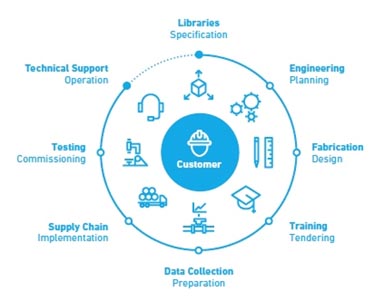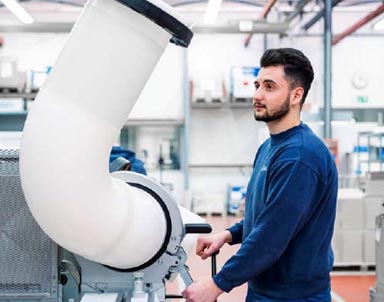Prefabricating Plastic Piping For Better Form, Fit, Function, And Financing
Thermoplastic piping systems have long proven their value for certain aspects of chemical and water conveyance at water and wastewater treatment facilities. Maximizing that value by using plastic piping specialists to help engineer and prefabricate the perfect piping designs offers multiple benefits, from pushing the design envelope to optimizing costs and timing.
A plastic piping system is not simply the implementation of a metallic piping design executed in a different material. It offers unique advantages for those able to accommodate its design requirements. Offsite prefabrication makes it easier to satisfy those requirements and minimize construction project concerns related to skilled labor shortages, space limitations, timing constraints, and cost overruns when supported by appropriate engineering insights unique to thermoplastic piping.
Here are some key benefits to consider when evaluating an initial prefabrication project or choosing the best supplier to implement one.
Balance These Building Blocks For Greater Efficiency
For consulting engineers, design-build firms, and water utilities interested in streamlining plastic piping system project costs and scheduling, prefabrication creates new opportunities for more efficient implementation. In most cases, the costs, conveniences, and capabilities of offsite prefabrication compare favorably to traditional, built-from-scratch, onsite assembly — even more so at remote locations.
- A Sound Business Concept. In construction circles, offsite prefabrication is a logical extension to the well-accepted concept of using specialty subcontractors. As a $120-billion segment of the construction market with a 6.9 percent rate of growth, it has certainly proved its worth. In fact, 90 percent of respondents to a Dodge Data & Analytics study agreed that prefabricated assemblies “improve productivity, quality, and scheduling as compared to traditional construction” and 80 percent added that it improved cost predictability, client satisfaction, and waste reduction.
- In-Depth Engineering. Harnessing the deep expertise of thermoplastic piping specialists does not conflict with the roles of in-house or consulting engineers; it complements them. Leveraging supplier expertise with plastic piping materials — with or without offsite prefabrication — helps all parties be most efficient in contributing their skills to the best overall implementation. Preconfigured digital libraries of components and design tools for plastic piping also make everyone’s job easier.
- Offsite Prefabrication. Using facilities and personnel dedicated to plastic pipe fabrication offers peace of mind and more opportunities to maximize value in terms of advanced designs, high-quality craftsmanship, specialized tooling, and testing capabilities. Having access to all necessary support services through a single source, often under one roof, can shorten the chain of command, improve communication, and consolidate responsibility for the entire project (Figure 1).

Graphic courtesy of GF Piping Systems
Figure 1. Working closely with an experienced thermoplastic piping supplier can give water treatment professionals, consulting engineers, and OEMs access to resources and insights for better design, fabrication, and testing options to maximize the value of new piping investments.
The Business Benefits Of Prefabrication And Engineering Support
Whether the ultimate objective is to ship discrete segments of onsite water treatment plant piping or deliver complete skid-mounted subsystems for inclusion in OEM-packaged systems, prefabrication offers multiple business benefits:
- Advanced Insights. In-plant and third-party designers can take advantage of engineering expertise from a single-source supplier of thermoplastic piping materials and fabrication services — on an ad-hoc basis or as a turnkey project service — to promote technical consistency from start to finish. Such appropriately designed subsystems also help to assure manufacturability for systems OEMs.
- Improved Timing. Overlapping the prefabrication cycle with the site preparation work cycle can significantly shorten the commissioning schedule as compared to build-outs that must take place in a linear timeframe. Keeping dedicated subassemblies separate from the onsite location can avoid conflicts and disruptions related to other activities at the job site. Choosing a supplier with a global footprint and fabrication facilities around the world also creates opportunities to improve the delivery cycle through shorter transit times and shared scheduling.
- Controlled Cost. Having the right components, tools, and equipment in a fabrication shop environment makes it quicker and easier to cut, assemble, and test repetitive assemblies — like manifolds, parallel piping layouts, and control panels — as well as one-of-a-kind designs. It also minimizes the time and expense lost to daily onsite setup and breakdown labor.
- Reduced Risk. Subassemblies built and tested by plastic piping specialists enable designers to push the envelope on complex designs without risking improper implementation by inexperienced subcontractors or in-house personnel.
- Increased Sophistication. Being able to fabricate piping and components in a dedicated environment with precision equipment matched to advanced fabrication techniques can open the door to more sophisticated designs than can be built onsite — from precision headers and subassemblies to complete skid-mounted systems.
- Consistent Craftsmanship. Having access to trained and certified assembly technicians who work with sophisticated plastic piping designs every day can inspire greater confidence than leaving it to randomly assigned plumbing subcontractors whose skillsets might not be as advanced. This includes appropriate fusion and cool-down timing on heat-fused joints or the cure time on solvent-cemented joints before handling and testing (Figure 2).

Photo courtesy of GF Piping Systems
Figure 2. Fabricating larger or more complex piping configurations can benefit from the specialized fusion equipment for the material being used and from the craftsmanship of the dedicated workforce at a prefabrication facility.
Maximizing The Advantages In Practice
Finally, to maximize the physical benefits of plastic piping systems executed through prefabrication services, here are four major checkpoints to keep in mind:
- Discuss Expectations Upfront. Because the devil is in the details, it pays to consult with plastic pipe design and fabrication experts before the needs of the application are finalized into a specific physical design. Reviewing design concepts and engineering concerns with thermoplastic piping specialists can streamline efficiency down the road.
- Make The Most Of The Medium. Plastic piping comes with unique performance advantages as well as unique design and installation requirements. Comparing the cost and performance implications of each in the evaluation stage will help to maximize payback and longevity in the appropriate execution.
- Avoid Preventable Failures. In the analysis of failed thermoplastic piping systems, the root cause is typically not a manufacturing defect in the pipes or fittings. It is often an omission or oversight in the design — e.g., insufficient thermal expansion/contraction loops or insufficient support relative to spacing designed for rigid metal pipe. Consulting with plastic piping experts in the design/review process can help to eliminate these types of surprises.
- Maximize Confidence. Take advantage of sophisticated testing and analytical services available from a prefabrication supplier to assure regulatory compliance and to protect the integrity of prefabricated structures during transit and installation.
 Brian LaBelle is Director of Business Development, Water Treatment & Energy for GF Piping Systems Americas, manufacturer of piping systems for the conveyance, measurement and control of gas and liquids in a wide variety of industrial, municipal and commercial applications. Mr. LaBelle is Vice-Chair of the AWWA Standards Committee for Online Monitoring, served two terms as Director-at-Large for the Measurement Control and Automation Association, is a published author and frequent speaker/presenter at major industry conferences, and has visited hundreds of water & wastewater treatment facilities and power plants around the world in a career that has so far spanned more than 30 years. Brian is also a magna graduate of California State Polytechnic University, Pomona and served 11 years in the US Naval Reserve.
Brian LaBelle is Director of Business Development, Water Treatment & Energy for GF Piping Systems Americas, manufacturer of piping systems for the conveyance, measurement and control of gas and liquids in a wide variety of industrial, municipal and commercial applications. Mr. LaBelle is Vice-Chair of the AWWA Standards Committee for Online Monitoring, served two terms as Director-at-Large for the Measurement Control and Automation Association, is a published author and frequent speaker/presenter at major industry conferences, and has visited hundreds of water & wastewater treatment facilities and power plants around the world in a career that has so far spanned more than 30 years. Brian is also a magna graduate of California State Polytechnic University, Pomona and served 11 years in the US Naval Reserve.
